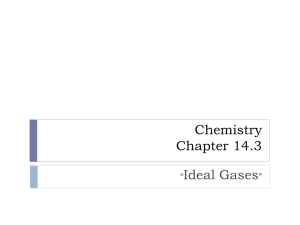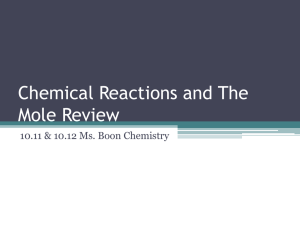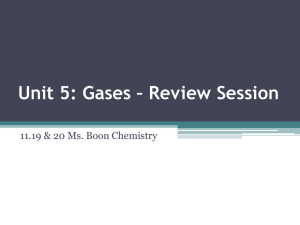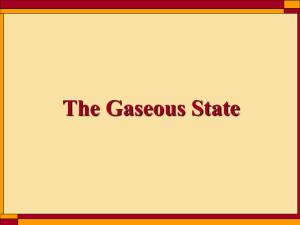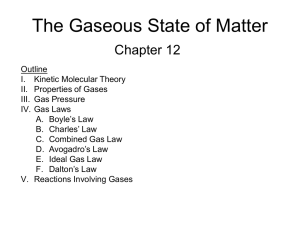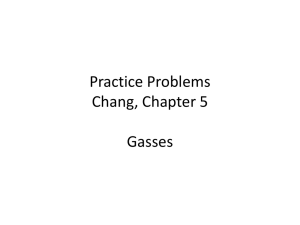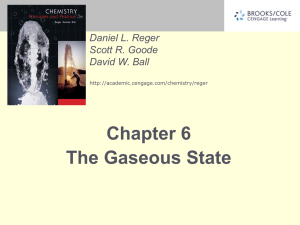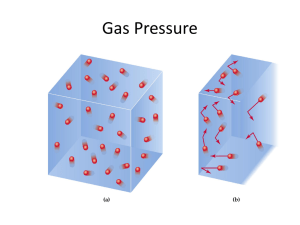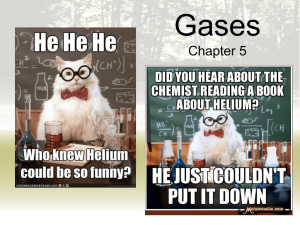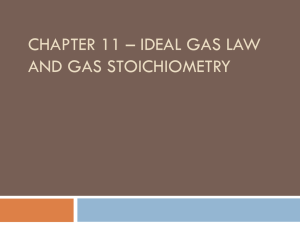Chapter-13 - Germainium.net
advertisement
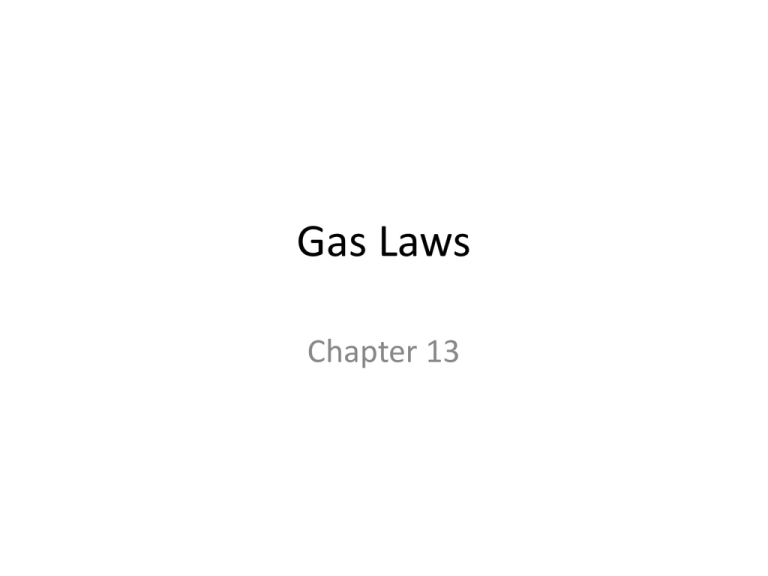
Gas Laws Chapter 13 Warm Up! • If you have a balloon filled with air and the temperature increased what would you observe? • what happens to the gas particles inside the balloon? • What would happen if the temperature was decreased? Today’s Agenda • QOTD: What are the variables involved in the behavior of gases and what are the laws that govern gas behavior? • Boyle’s Law • Charles’ Law • Gay-Lusacc’s Law Gas Laws • We are considering 4 variables: • V = volume n = moles • T = temperature P = pressure • Simulation: http://phet.colorado.edu/en/simulation/gasproperties • We want to know if you change one variable, how does that affect the other measurements? Relationships of P,V,T,n • Remember that: P=F A • Volume is related to area, so as volume gets larger the area will increase and P will decrease • Volume and pressure are INVERSELY related. • Temperature and moles are related to force because as T increases it will result in more collisions – meaning larger forces. Also, more moles means more “stuff” to collide and larger forces . The larger the forces the higher the pressure . • Temperature/moles are DIRECTLY related to pressure. Gas Law’s • The individual gas laws assume that you hold all other variables that are NOT used constant! • Boyles Law – Describes the inverse relationship between volume and pressure • As volume decreases, pressure increases. P1V1=P2V2 Using Boyle’s Law When conditions change, you solve for a new volume or pressure. Example! A balloon filled with gas at a pressure of 1.3 atm has a volume of 2.2 L. When the volume is increased to 4.1 L what is the new pressure? Boyle’s Law • Your turn! • What is the volume of a gas if 0.76 L of a gas is in a piston at 820 mmHg of pressure if the pressure is reduced to 610 mmHg? Gas Laws • Charles’ Law - Describes the direct relationship between volume and temperature. • As volume increases, temp increases! • V1 = V 2 T1 T2 is the same as T1 = T2 V1 V2 Using Charles’ Law When conditions change, you solve for a new temperature or volume. Example! A balloon filled with gas has a volume of 2.2 L at 298K . When the balloon is heated to 355 K what is the new volume? Charles’ Law • Your turn! • A gas mixture at 400K occupies a volume of 2.76 L. If the volume is decreased to 1.32 L what is the temperature? Gas Laws • Gay-Lussac’s Law – Describes the direct relationship between temperature and pressure. • As temperature increases, pressure increases. • P1 = P2 is the same as T1 = T2 T1 T2 P1 P2 Using Gay-Lussac’s Law When conditions change, you solve for a new temperature or pressure. Example! • Gas particles are at standard pressure and temperature in a rigid container. When the container is heated at 373 K, what is the new pressure? Gay-Lussac’s Law • Your turn! • What is the temperature of a gas in a sealed rigid container at 268 kPa, if initially it was at a temperature of 200 K and a pressure of 85 kPa. Gas Laws • Combined Gas Law – relates pressure, temperature and volume and assumes moles is held constant. • All the relationships in one tidy law! • P1V1 = P2V2 T1 T2 is the same as T1 = T2 P1V1 P2V2 Combined Gas Law • When conditions change, you solve for a new pressure, temperature, or volume! • Example • A 350 mL sample of helium gas is collected at 22.0 oC and 99.3 kPa. What volume would this gas occupy at STP? Combined Gas Law • Your turn! • Initially a gas is at a pressure of 12 atm, a volume of 23 liters, and a temperature of 200 K. The pressure is raised to 14 atm and temperature increased to 300 K, what is the new volume of the gas? Warm Up! • A gas has a final volume of 22.4 L at STP. What was the initial volume measured at 810 mmHg and 200 K? • What is the missing variable in the combined gas law? • Considering P= F/A, where would this last variable belong if added to the combined gas law? Todays Agenda • QOTD: What is the ideal gas constant and how is it calculated? • Avogadros Principle • Ideal gas constant and law • Calculating density and molar masses • Lab Books Due Thurs pm (Baking Soda Lab)! • All bookwork and Gas Law Packet due Friday Combined Gas Law • Combined Gas Law – relates pressure, temperature and volume and assumes moles is held constant. • P=F F related to T Where does moles fit? A A related to V • P1V1 = P2V2 T1 T2 is the same as T1 = T2 P1V1 P2V2 The missing variable – n! Avogadro’s Principle - Equal volumes of gases contain the SAME number of particles • Molar volume of a gas – volume that 1 mol occupies at STP (273K and 1 atm) • What is that volume??? 22.4 L Ideal Gas Constant • Combined Gas law, plug in values from warm up and see if both sides are equal… P1V1 = P2V2 0.0821 = 0.0821 T1 T2 • For a specific sample of gas – relationship between pressure, volume, and temp is ALWAYS the same PV = R = .0821 L atm/mol K T Deriving the Ideal Gas Law • Use the combined gas law and R, add in moles and….. PV = R rearranges to PV = nRT nT In class practice: Calculate the number of moles of ammonia gas (NH3) contained in a 3.0 L vessel at 300 K and 1.50 atm of pressure. Your turn! • Determine the temperature (in °C) of 2.49 mol of a gas contained in a 1.0 L vessel at 143 kPa. (Remember that because of R, your calculations have to be in Kelvin and atm!) Make an inventory and remember your conversions! Warm Up! • Find the pressure at which 2.05 moles of gas occupy 1.5 L at 298K. • How many moles of oxygen gas occupy a 3 L tank at STP? Today’s Agenda • QOTD: How can you calculate density of gases using the ideal gas law and when are gases non-ideal? • Density and mass derivations • REAL gases • Practice Problems Finding Molar Mass • You can use the ideal gas law to find the molar mass of an unknown gas! • Remember: moles (n) = mass (g) molar mass (g/mol) So we replace n with m/MM in PV = nRT PV = mRT which rearranges to MM = mRT MM PV Substituting with Density • Since MM = mRT , and we know that PV D = m/v how can we use density to find MM? MM = DRT P In summary, PV = nRT and since n = m/MM then MM = mRT/PV AND since d = m/v now MM = DRT/P! Practice Problem • What is the molar mass of gerinol (a compound found in perfumes) if its vapor has a density of 0.480 g/L at a temperature of 260 °C and a pressure of 0.140 atm? Your Turn! 1. Rearrange MM= DRT/P to solve for D. 2. Determine the density of chlorine gas at 295K and 1 atm. Warm Up! • Find the pressure at which 2.05 moles of gas occupy 1.5 L at 298K. • How many grams of oxygen gas are contained in 3.25 L at STP? • Find the density of Kr gas at STP. Today’s Agenda • QOTD: How do real gases behave? • Non-ideal behavior • Practice Problems Deviations of REAL gases • Remember that the IDEAL gas law assumes that all gases behave ideally as described by kinetic molecular theory. • Gas particles are tiny - take up negligible volume • Gases experience no intermolecular attractions • Collisions of gas particles are perfectly elastic and do not lose energy. Gases aren’t really IDEAL • Gas particles are small but do take up volume. • Gases do experience some intermolecular attractions • Collisions are not perfectly elastic and some energy is lost. BUT • Most gases behave similarly to ideal so we can still use the ideal gas law to approximate them! Factors Contributing to Non-Ideal Behavior • Gases can not be approximated accurately by the ideal gas law at really HIGH PRESSURE and really LOW TEMPERATURE Why? Consider IMF’s and phases Factors Contributing to Non-Ideal Behavior • Gases are less ideal when: A gas is HIGHLY POLAR or has LARGE PARTICLES Why? Warm Up! • A 250 mL flask is filled with helium gas at a pressure of 1.2 atm and a 130 K. What is the mass of helium in the flask? • If the same sample of helium was stored at STP, what is the final volume? • How do you determine if the units of P, V, and T are the RIGHT units?? Today’s Agenda • QOTD: None, review! • Combined/Ideal worksheet – classwork only • Quiz tomorrow: Combined gas law, ideal gas, law, ideal gas with mass and density. You will be given PV=nRT, R = 0.0821 Latm/molK, and P1V1/T1 = P2V2/T2 • Lab books due TODAY (baking soda lab) • HW: Completed Gas Law, Ideal gas law packets and Combined Gas Law Sheet due tomorrow! Warm Up! • Write the balanced equation for the reaction of nitrogen and hydrogen gases reacting to form ammonia (NH3). • What is the mole ratio of nitrogen and hydrogen gases? • What is the mole ratio of hydrogen gas to ammonia? Today’s Agenda • QOTD: How can you use the ideal gas law with the chemical reaction to calculate stoichiometry of a gas reaction. • • • • • Stoichiometry with gas reactions Volume – Volume Problems Mass – Volume Problems Classwork Problems Homework (Due Wed) – Ch 13: 80 to 98 evens Stoichiometry with Ideal Gas Law • Remember the key to stoichiometry is a balanced chemical eqn. – Review formula writing/naming, types of reactions, and balancing reactions if you need help!! • When gases react the coefficients in the balanced equation represent both molar amounts and relative volumes! Volume-Volume Stoich of Gases • What volume of oxygen gas is needed for the combustion of 4.0 L of propane gas (C3H8)? • C3H8 + 5O2 3CO2 + 4H2O • Given : V = 4.0 L C3H8 Want : V = ? L O2 • 4.0 L C3H8 x 5 volume units O2 = 20.0 L O2 1 volume unit C3H8 Your Turn! • How many liters of propane gas (C3H8) will undergo complete combustion with 34.0 L of O2 gas? • Determine the volume of hydrogen gas needed to react completely with 5.0 L of oxygen gas to form water. Volume-Mass Stoich of Gases • Ammonia (NH3) is synthesized from nitrogen and hydrogen. If 5.0 L of nitrogen reacts completely with hydrogen at a pressure of 3.0 atm and a temperature of 298 K, how much ammonia, in grams, is produced? • Write the balanced equation! N2 + 3H2 2NH3 • Given: V = 5.0 L P = 3.00 atm T = 298 K Want: m = ? g NH3 2. Convert from liters of N2 to liters of NH3 5.0 L N2 x 2 volume units NH3 = 10.0 L NH3 1 volume unit N2 N2 + 3H2 2NH3 3. Use the ideal gas law to calculate moles of NH3 PV = n RT 3 atm x 10.0 L NH3 = 1.23 mol NH3 0.0821Latm/molK x 298 K 4. Convert moles of NH3 to grams 1.23 mol NH3 x 17 g NH3 = 21 g NH3 1 mol NH3 Set up Eqn and Solve! Your Turn! • Ammonium nitrate decomposes into dinitrogen monoxide and water. Calculate the mass of solid ammonium nitrate that must be used to obtain 0.1 L of dinitrogen monoxide gas at STP.
